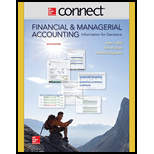
Statement of
The statement of cash flow is a financial statement, which provides a summary of actual or anticipated
The cash flow statement is categorized into three parts as follows:
► Cash flow from operating activities: All those activities that are related to production, sales, and delivery of an organization’s product or service and collection of payments from customers come under this category. For example: Losses, gains, purchase of raw material, inventory,
► Cash flow from investing activities: When an organization purchases or sells any asset, then whatever cash comes in or goes out are reported under this head of the cash flow statement. If any loan is made to a supplier or received from a customer then, it would be reported in it and if a merger or acquisition exists there, then all the payments related to it would also be recorded in it.
► Cash flow from financing activities: The inflow of cash from investors like bank and shareholders and outflow to shareholders in the form of dividends is recorded under this head of the cash flow statement. All those activities that affect the long-term liabilities or equity of the organization will also be reported under this head.
To prepare: The complete cash flow statement using the direct method.
Want to see the full answer?
Check out a sample textbook solution
Chapter 12 Solutions
Connect 2 Semester Access Card for Financial and Managerial Accounting
- Hello tutor please provide correct answer general accounting questionarrow_forwardRobinson Manufacturing discovered the following information in its accounting records: $519,800 in direct materials used, $223,500 in direct labor, and $775,115 in manufacturing overhead. The Work in Process Inventory account had an opening balance of $72,400 and a closing balance of $87,600. Calculate the company’s Cost of Goods Manufactured.arrow_forwardSanjay would like to organize HOS (a business entity) as either an S corporation or as a corporation (taxed as a C corporation) generating a 16 percent annual before-tax return on a $350,000 investment. Sanjay’s marginal tax rate is 24 percent and the corporate tax rate is 21 percent. Sanjay’s marginal tax rate on individual capital gains and dividends is 15 percent. HOS will pay out its after-tax earnings every year to either its members or its shareholders. If HOS is taxed as an S corporation, the business income allocation would qualify for the deduction for qualified business income (assume no limitations on the deduction). Assume Sanjay does not owe any additional Medicare tax or net investment income tax. Required 1. For each scenario, C corporation and S corporation, calculate the total tax (entity level and owner level). 2. For each scenario, C corporation and S corporation, calculate the effective tax rate. C Corporation S Corporation 1. Total tax…arrow_forward
- I need correct solution of this general accounting questionarrow_forwardHii expert please given correct answer general accountingarrow_forwardMarkowis Corp has collected the following data concerning its maintenance costs for the pest 6 months units produced Total cost July 18,015 36,036 august 37,032 40,048 September 36,036 55,055 October 22,022 38,038 November 40,040 74,575 December 38,038 62,062 Compute the variable coot per unit using the high-low method. (Round variable cost per mile to 2 decimal places e.g. 1.25) Compute the fixed cost elements using the high-low method.arrow_forward
- Use the following data to determine the total dollar amount of assets to be classified as current assets. Marigold Corp. Balance Sheet December 31, 2025 Cash and cash equivalents Accounts receivable Inventory $67000 Accounts payable $126000 86500 Salaries and wages payable 11100 149000 Bonds payable 161500 Prepaid insurance 83000 Total liabilities 298600 Stock investments (long-term) 193000 Land 199500 Buildings $226000 Common stock 309400 Less: Accumulated depreciation (53500) 172500 Retained earnings 475500 Trademarks 133000 Total stockholders' equity 784900 Total assets $1083500 Total liabilities and stockholders' equity $1083500 ○ $269100 $385500 ○ $236500 ○ $578500arrow_forwardShould the machine be replaced?arrow_forwardUsing the following balance sheet and income statement data, what is the total amount of working capital? Current assets $39700 Net income $52100 Current liabilities 19800 Stockholders' equity 96700 Average assets 198400 Total liabilities 52100 Total assets 148800 Average common shares outstanding was 18600. ○ $9900 ○ $39700 ○ $19900 ○ $12400arrow_forward
- Suppose that Old Navy has assets of $4265000, common stock of $1018000, and retained earnings of $659000. What are the creditors' claims on their assets? ○ $2588000 ○ $3906000 ○ $1677000 ○ $4624000arrow_forwardBrody Corp. uses a process costing system. Beginning inventory for January consisted of 1,400 units that were 46% completed. 10,300 units were started during January. On January 31, the inventory consisted of 550 units that were 77% completed. How many units were completed during the period?arrow_forwardCurrent Attempt in Progress Whispering Winds Corp. has five plants nationwide that cost $275 million. The current fair value of the plants is $460 million. The plants will be reported as assets at $735 million. O $460 million. $275 million. O $185 million.arrow_forward

 AccountingAccountingISBN:9781337272094Author:WARREN, Carl S., Reeve, James M., Duchac, Jonathan E.Publisher:Cengage Learning,
AccountingAccountingISBN:9781337272094Author:WARREN, Carl S., Reeve, James M., Duchac, Jonathan E.Publisher:Cengage Learning, Accounting Information SystemsAccountingISBN:9781337619202Author:Hall, James A.Publisher:Cengage Learning,
Accounting Information SystemsAccountingISBN:9781337619202Author:Hall, James A.Publisher:Cengage Learning, Horngren's Cost Accounting: A Managerial Emphasis...AccountingISBN:9780134475585Author:Srikant M. Datar, Madhav V. RajanPublisher:PEARSON
Horngren's Cost Accounting: A Managerial Emphasis...AccountingISBN:9780134475585Author:Srikant M. Datar, Madhav V. RajanPublisher:PEARSON Intermediate AccountingAccountingISBN:9781259722660Author:J. David Spiceland, Mark W. Nelson, Wayne M ThomasPublisher:McGraw-Hill Education
Intermediate AccountingAccountingISBN:9781259722660Author:J. David Spiceland, Mark W. Nelson, Wayne M ThomasPublisher:McGraw-Hill Education Financial and Managerial AccountingAccountingISBN:9781259726705Author:John J Wild, Ken W. Shaw, Barbara Chiappetta Fundamental Accounting PrinciplesPublisher:McGraw-Hill Education
Financial and Managerial AccountingAccountingISBN:9781259726705Author:John J Wild, Ken W. Shaw, Barbara Chiappetta Fundamental Accounting PrinciplesPublisher:McGraw-Hill Education





